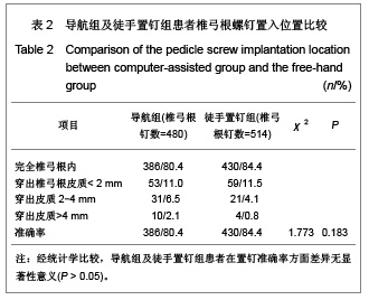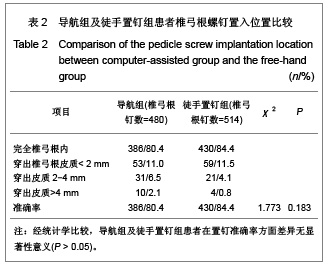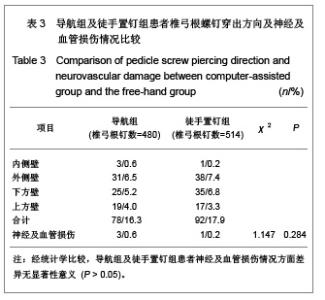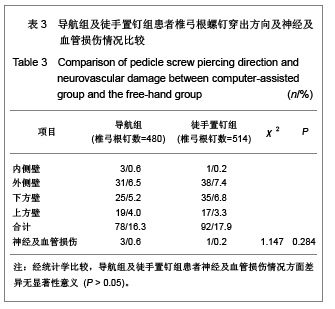| [1] Amoit LP,Labelle H,DeGuise JA,et al. Computer-assisted pedicle screw fixation. A feasibility study. Spine.1995;20: 1208-1212.[2] Richter M, Mattes T, Cakir B. Computer-assisted posterior instrumentation of the cervical and cervico-thoracic spine. Eur Spine J.2004;13:50-59.[3] Tian W. Jizhu Waike Zazhi. 2003;1(1):15-18. 田伟.透视及导航下颈椎椎弓根螺钉内固定术的临床应用经验[J].脊柱外科杂志,2003,1(1): 15-18.[4] Gains RW.The use of pedicle screw internal fixation for the operative treatment 0f spinal disorder.J Bone Joint Surg Am. 2000;82:1458-1476.[5] Esses SI,Sachs BL,Dreyzin V. Complications associated with the technjque of pedicle screw fixation:a Selection survey of ABS members. Spine.1993;18:2231-2239.[6] Roy-Camile R, Saillant G, Mazel C. Internal ?xation of the lumbar spine with pedicle screw plating. Clin Orthop Relat Res. 1986 ;203:7-17.[7] Gertzbein SD, Robbins SE. Accuracy of pedicular screw placement in vivo. Spine.1990; 15:11-14.[8] Laine T, Makitalo K, Schlenzka D, et al. Accuracy of pedicle screw insertion: a prospective CT study in 30 low back patients. Eur Spine J.1997;6:402-405.[9] Xu L, Yu X,Zheng DB, et al. Zhongguo Jiaoxing Waike Zazhi. 2004;12(12):1895-1897. 徐林,俞兴,郑大滨,等.脊柱导航三维影像系统在椎弓根螺钉固定术中的应用[J].中国矫形外科杂志,2004,12(12):1895-1897.[10] Laine T, Lund T, Ylikoski M, et al.Accuracy of pedicle screw insertion with and without computer assistance: a randomised controlled clinical study in 100 consecutive patients. Eur Spine J.2000;9:235-240.[11] Tian NF, Huang QS, Zhou P, et al. Pedicle screw insertion accuracy with different assisted methods:a systematic review and meta-analysis of comparative studies.Eur Spine J. 2011; 20(6):846-859. [12] Rajeev V, Sonal K, Kurt H, et al. Functional outcome of computer-assisted spinal pedicle screw placement: a systematic review and meta-analysis of 23 studies including 5,992 pedicle screws. Eur Spine J. 2010;19:370-375. [13] Gelalis ID, Paschos NK, Pakos EE,et al. Accuracy of pedicle screw placement: a systematic review of prospective in vivo studies comparing free hand, fluoroscopy guidance and navigation techniques. Eur Spine J. 2012;21(2):247-255. [14] Li SG, Sheng L, Zhao H, et al. Zhonghua Yixue Zazhi. 2009; 89(11):736-739. 李书纲,盛林,赵宏,等.计算机导航技术在脊柱脊柱椎弓根钉固定中的应用[J].中华医学杂志,2009,89(11): 736-739.[15] Silbermann J, Riese F, Allam Y. Computer tomography assessment of pedicle screw placement in lumbar and sacral spine: comparison between free-hand and O-arm based navigation techniques. Eur Spine J. 2011;20(6):875-881. [16] Kawaguchi Y, Nakano M, Yasuda T,et al. Development of a New Technique for Pedicle Screw and MagerlScrew Insertion Using a 3D Image Guide. Spine (Phila Pa 1976). 2012. [Epub ahead of print] [17] Rajasekaran S, Perumal SV, Shetty AP,et al. Randomized clinical study to compare the accuracy of navigated and non-navigated thoracic pedicle screws in deformity correction surgeries. Spine. 2007; 32:E56-64.[18] Machino M, Yukawa Y, Ito K,et al. Cervical pedicle screw fixation in traumatic cervical subluxation after laminectomy using the pedicle axis view technique under fluoroscopy. BMJ Case Rep. 2012; pii: bcr-2012-006545. [19] Larson AN, Polly DW Jr, Guidera KJ, et al. The accuracy of navigation and 3D image-guided placement for the placement of pedicle screws in congenital spine deformity. J Pediatr Orthop. 2012;32(6):e23-29. [20] Cui G, Wang Y, Kao TH, et al. Application of intraoperative computed tomography with or withoutnavigation system in surgical correction of spinal deformity: a preliminary result of 59 consecutive human cases. Spine (Phila Pa 1976). 2012; 37(10):891-900. [21] Tian W, Liu Y, Zheng S, et al. Accuracy of lower cervical pedicle screw placement with assistance of distinct navigation systems: a human cadaveric study.Eur Spine J. 2012. [Epub ahead of print] [22] Waschke A, Walter J, Duenisch P, et al. CT-navigation versus fluoroscopy-guided placement of pediclescrews at the thoracolumbar spine: single center experience of 4,500 screws. Eur Spine J. 2012. [Epub ahead of print] [23] Tian W, Weng C, Liu B, et al. Posterior fixation and fusion of unstable Hangman's fracture by using intraoperative three-dimensional fluoroscopy-basednavigation. Eur Spine J. 2012;21(5):863-871. [24] Yoshida G, Kanemura T, Ishikawa Y. Percutaneous Pedicle Screw Fixation of a Hangman's Fracture Using Intraoperative, Full Rotation, Three-dimensional Image (O-arm)-based Navigation: A Technical Case Report. Asian Spine J. 2012; 6(3):194-198. |





